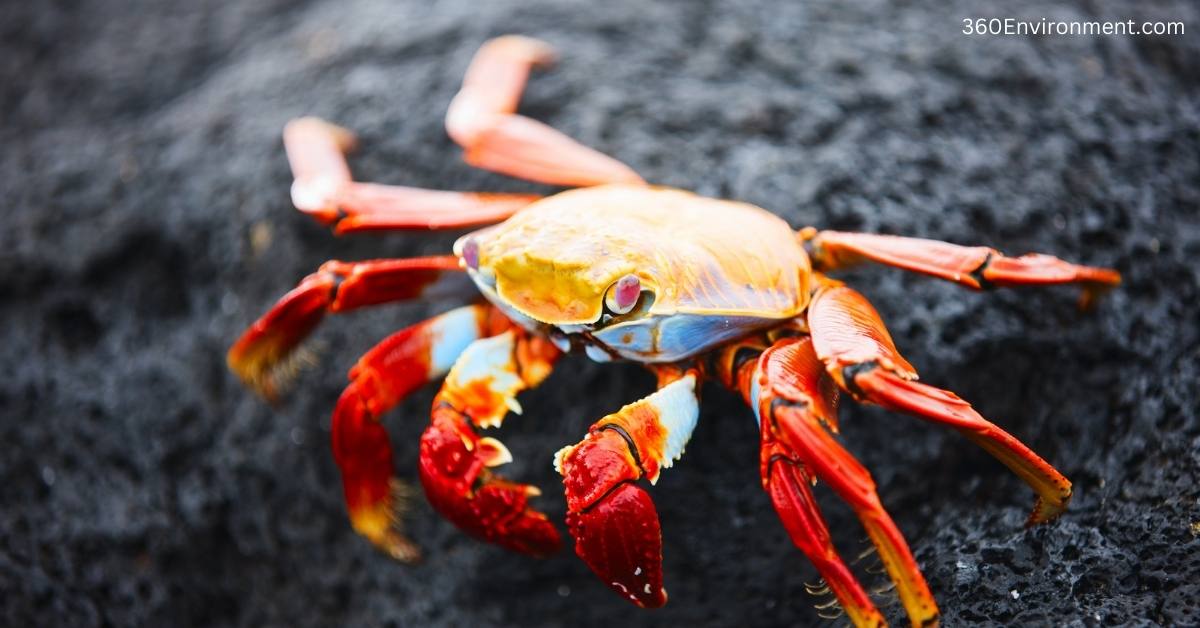The Sally Lightfoot crab (Grapsus grapsus) is one of the most visually striking and iconic crabs found along the coasts of the Americas, especially on the volcanic shores of the Galápagos Islands. With its vibrant red, orange, and blue hues, this agile crustacean has captured the attention of naturalists and photographers alike. However, beyond its aesthetic appeal, the Sally Lightfoot crab plays a vital role in its ecosystem. This article explores the environmental niche of the Sally Lightfoot crab, delving into its habitat, diet, behavior, ecological interactions, and the significance of its role in coastal ecosystems.
1. Overview of the Sally Lightfoot Crab (Grapsus grapsus)
The Sally Lightfoot crab belongs to the family Grapsidae, a group of crabs commonly found along rocky shorelines. Known for its agility and ability to navigate rough terrain, this species is sometimes referred to as the “red rock crab.” While its bright coloring makes it easy to spot, the crab is a master of movement, able to scuttle quickly across rocks, evade predators, and leap between gaps with ease. Its name, “Sally Lightfoot,” is believed to come from its light and nimble movement, much like that of a dancer.
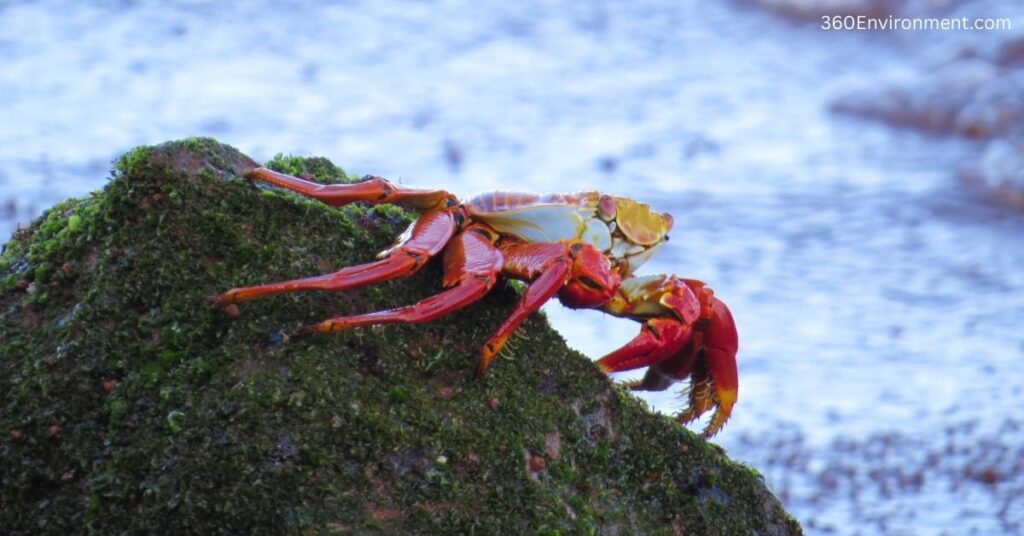
1.1 Taxonomy and Classification
- Kingdom: Animalia
- Phylum: Arthropoda
- Class: Malacostraca
- Order: Decapoda
- Family: Grapsidae
- Genus: Grapsus
- Species: Grapsus grapsus
The Sally Lightfoot crab is a quintessential example of a species that has evolved to thrive in one of the most challenging coastal environments on Earth. Its adaptability and resilience make it an integral part of the ecological fabric of rocky shorelines.
1.2 Morphological Characteristics
One of the most distinguishing features of the Sally Lightfoot crab is its vibrant coloring, which includes bright red and orange tones, mixed with blue, green, and yellow highlights, particularly on the underside of its body. These colors are especially pronounced in adult crabs, while juveniles tend to be darker and more cryptic to blend in with their surroundings.
- Size: Adult Sally Lightfoot crabs can grow to around 8 to 12 cm (3 to 5 inches) in shell width.
- Exoskeleton: Like all crabs, the Sally Lightfoot has a hard exoskeleton that provides protection against predators and environmental stressors. The exoskeleton is molted periodically to allow for growth.
- Legs and Movement: The crab’s legs are long and agile, with flattened segments that help it cling to rocks. The agile movement of this crab allows it to evade predators and navigate across the slippery, wave-battered rocks of its habitat.
2. Habitat and Geographic Distribution
The Sally Lightfoot crab is most commonly found along the Pacific coasts of Central and South America, from Mexico to northern Chile, as well as the Galápagos Islands. Its habitat is characterized by rocky shorelines where it can find shelter in crevices, feed on algae, and avoid the surf’s constant pounding. This crab is adapted to live in the intertidal zone, where it experiences both marine and terrestrial environments.
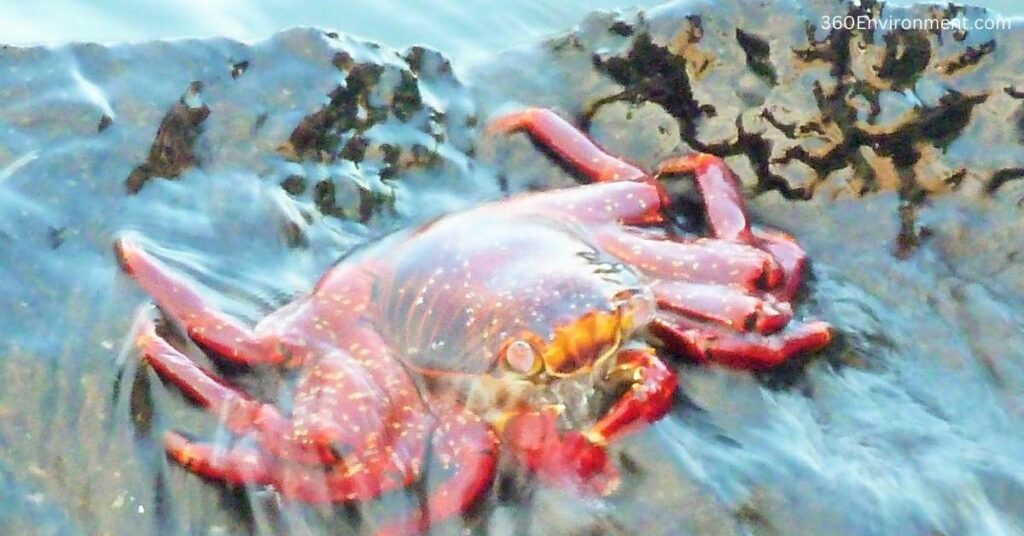
2.1 Habitat Preferences
The Sally Lightfoot crab is a species that thrives in the intertidal zone, the area between the high and low tide marks. This environment is subject to extreme variations in temperature, moisture, and wave action, making it a challenging place to live. However, Sally Lightfoot has evolved a number of adaptations that allow it to survive and even thrive in these conditions.
- Rocky Shorelines: The primary habitat of the Sally Lightfoot crab is rocky shorelines, where it can find ample food and shelter. These environments provide hiding spots in crevices and under rocks, protecting the crabs from predators and strong waves.
- Tidal Pools: Sally Lightfoot crabs are often found around tidal pools, which provide access to both marine and terrestrial food sources. The ability to move between land and water gives the crab access to a wide variety of prey, including algae, detritus, and small marine animals.
- Galápagos Islands: The Galápagos Islands, where the crab is especially abundant, offer an ideal habitat due to the island’s rocky, volcanic shores. The crab’s bright coloring is often seen against the backdrop of black volcanic rocks, creating a striking contrast that is iconic in images of Galápagos wildlife.
2.2 Geographic Distribution
The geographic distribution of the Sally Lightfoot crab spans the tropical and subtropical coasts of the eastern Pacific Ocean. Its range extends from Baja California and Mexico in the north, down through Central America, and as far south as northern Chile.
- Eastern Pacific: The Sally Lightfoot crab is commonly found along the Pacific coasts of Central and South America, inhabiting the rocky shores and intertidal zones of countries such as Mexico, Costa Rica, Ecuador, and Peru.
- Galápagos Islands: Perhaps the most famous population of Sally Lightfoot crabs is found in the Galápagos Islands. The unique volcanic landscape of the islands provides a perfect habitat for the crabs, and they are a common sight along the shorelines of these remote islands.
3. Feeding Behavior and Diet
The Sally Lightfoot crab is an omnivorous species, feeding on a wide variety of food sources that are available in the intertidal zone. Its diet consists primarily of algae, but it is also known to scavenge for detritus and feed on small marine organisms.
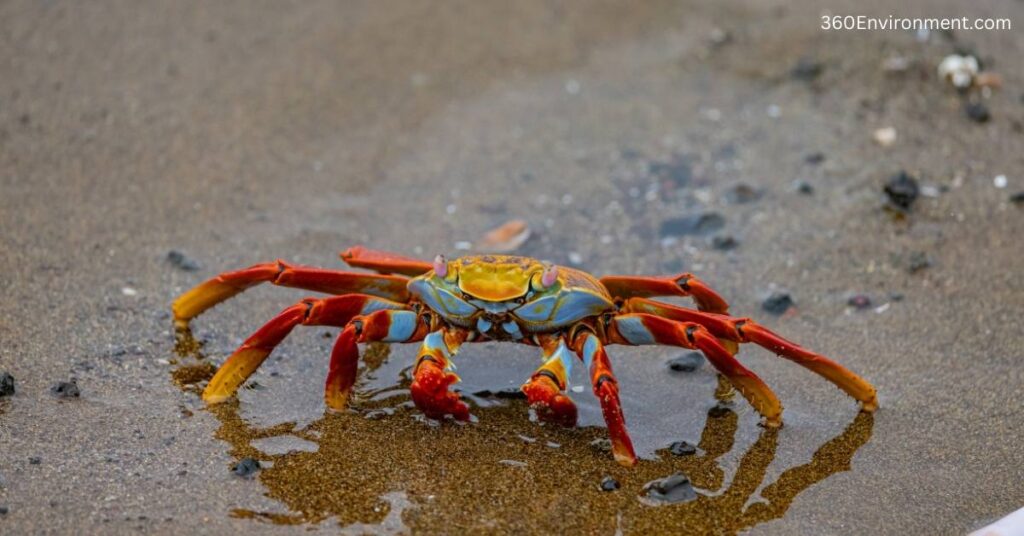
3.1 Primary Food Sources
As a versatile forager, the Sally Lightfoot crab consumes both plant and animal matter. Its ability to feed on a wide variety of materials makes it an important part of the food web in coastal ecosystems.
- Algae: Algae forms the bulk of the Sally Lightfoot crab’s diet. The crab uses its sharp pincers to scrape algae off rocks, consuming a variety of species, including green, brown, and red algae. This feeding behavior helps control algal growth in the intertidal zone.
- Detritus: In addition to algae, the Sally Lightfoot crab also scavenges for organic detritus, including dead plant material and decaying animals. This behavior plays a key role in nutrient cycling, as the crab helps break down organic matter and return nutrients to the ecosystem.
- Small Marine Organisms: Although primarily herbivorous, the Sally Lightfoot crab will occasionally prey on small marine animals, such as mollusks and crustaceans. This opportunistic feeding strategy allows the crab to take advantage of whatever food is available in its environment.
3.2 Foraging Behavior
The Sally Lightfoot crab is a highly active and agile forager, often seen scuttling across rocks in search of food. Its ability to move quickly and navigate difficult terrain allows it to access food sources that might be out of reach for other animals.
- Daytime Foraging: Unlike many other crab species that are nocturnal, the Sally Lightfoot crab is active during the day. This diurnal activity sets it apart from many other intertidal organisms and allows it to exploit different food sources.
- Algae Scraping: The crab’s specialized pincers are well-suited for scraping algae off rocks, a behavior that is essential for its survival. By consuming algae, the crab plays a critical role in controlling algal growth on rocky shorelines, helping to maintain a balanced ecosystem.
4. Reproduction and Life Cycle
The reproductive behavior of the Sally Lightfoot crab follows the general pattern observed in many crab species, with females laying eggs that hatch into free-swimming larvae. The life cycle of the crab involves several stages, each adapted to the challenges of the intertidal zone.
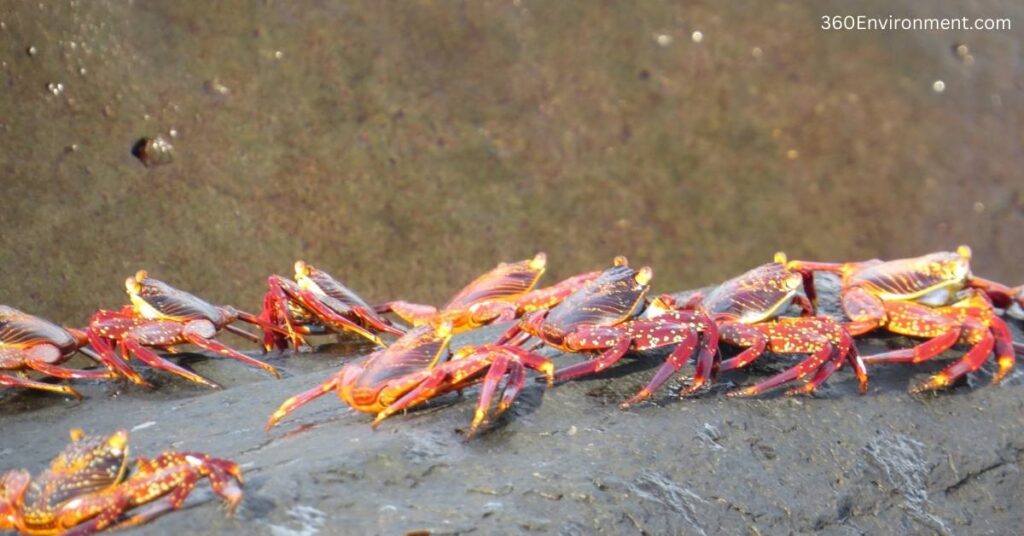
4.1 Mating and Reproduction
Mating for the Sally Lightfoot crab typically occurs during the warmer months, when food is abundant, and environmental conditions are favorable for the survival of offspring.
- Mating Behavior: Male crabs attract females through a combination of displays and physical contact. Once a mate is selected, fertilization occurs internally. Females can store sperm and fertilize multiple batches of eggs over time.
- Egg Laying: After mating, the female carries her fertilized eggs on her abdomen, where they are protected until they hatch. The number of eggs laid can vary, but females can produce thousands of eggs in a single reproductive cycle.
4.2 Larval Stage and Development
Once the eggs hatch, the larvae enter a planktonic stage, where they drift in the water column and feed on microscopic plankton. This free-swimming stage is a critical period in the life cycle of the Sally Lightfoot crab, as the larvae are vulnerable to predation and environmental conditions.
- Larval Stage: During this stage, the larvae undergo several molts, gradually developing into juvenile crabs. The larval stage lasts several weeks, after which the young crabs settle in the intertidal zone and begin their life on the rocky shorelines.
- Juvenile Development: Juvenile crabs resemble adults but are smaller and darker in color, providing them with better camouflage from predators. As they grow, the crabs molt their exoskeletons, gradually developing the bright colors characteristic of adults.
5. Predators and Defense Mechanisms
Despite their agility and hard exoskeleton, Sally Lightfoot crabs are preyed upon by a variety of animals, including birds, fish, and larger crabs. To survive in the challenging intertidal zone, the crab has developed several defense mechanisms that help it avoid predation.
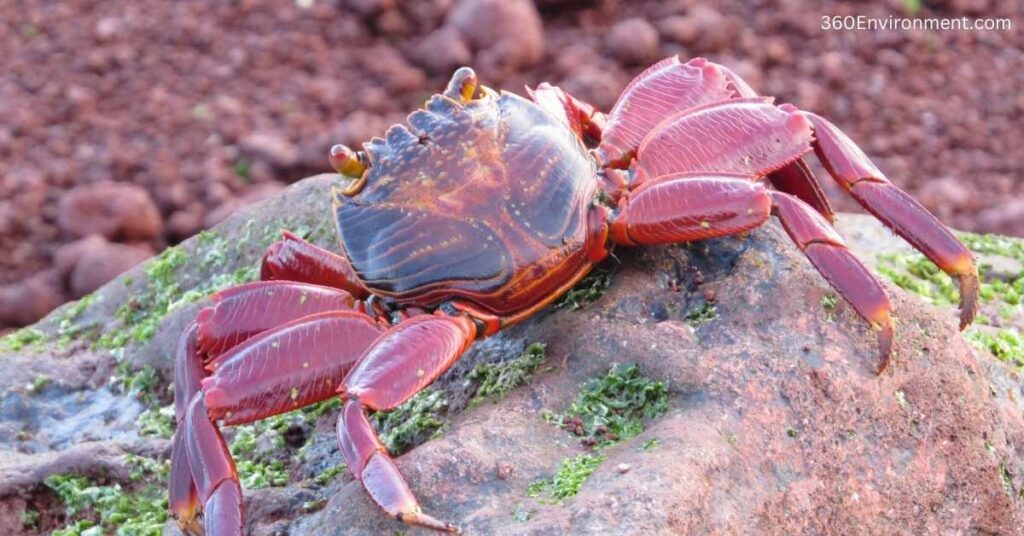
5.1 Natural Predators
The Sally Lightfoot crab is an important prey species for many coastal predators. Its bright coloring and daytime activity make it an easy target for both terrestrial and marine predators.
- Birds: Seabirds, such as gulls and herons, are among the most common predators of the Sally Lightfoot crab. These birds are highly adept at catching crabs as they scuttle across rocks or forage for food.
- Fish and Eels: In the water, fish and eels prey on the crab, particularly when it is in the water or near tidal pools. The crab’s ability to move quickly between land and sea helps it evade these aquatic predators.
- Larger Crabs: Other crab species, particularly larger ones, may prey on juvenile Sally Lightfoot crabs. The competition for food and space in the intertidal zone can lead to cannibalistic behavior, especially when food is scarce.
5.2 Defense Mechanisms
To avoid predation, the Sally Lightfoot crab relies on a combination of speed, agility, and camouflage. These defense mechanisms allow the crab to survive in an environment where predators are abundant.
- Agility: The Sally Lightfoot crab’s agility is its primary defense against predators. Its ability to move quickly and leap between rocks allows it to evade birds and other predators with ease. The crab can change direction rapidly, making it difficult for predators to catch.
- Camouflage: While adult crabs are brightly colored, juveniles are much darker and better camouflaged. This coloration helps protect young crabs from predators while they are still small and vulnerable.
- Hiding in Crevices: The rocky shorelines where the Sally Lightfoot crab lives are filled with crevices and cracks that provide shelter from predators. The crab uses these hiding spots to escape when threatened.
6. Ecological Role of the Sally Lightfoot Crab
The Sally Lightfoot crab plays a critical role in the ecosystems it inhabits. As both a consumer of algae and detritus and a prey species for larger animals, the crab contributes to the overall health and balance of coastal ecosystems.

6.1 Algal Control
One of the most important ecological functions of the Sally Lightfoot crab is its role in controlling algal growth. By feeding on algae, the crab helps prevent algal overgrowth, which can smother rocks and other surfaces in the intertidal zone.
- Keystone Species: In many rocky shore ecosystems, the Sally Lightfoot crab acts as a keystone species, meaning that its feeding behavior has a disproportionate impact on the structure of the ecosystem. By controlling algal growth, the crab helps maintain the diversity of other organisms that rely on the same habitat.
- Ecosystem Engineers: The feeding activity of the Sally Lightfoot crab helps shape the physical environment of the intertidal zone. By scraping algae off rocks, the crab keeps surfaces clear for other species, such as barnacles and mollusks, to settle.
6.2 Prey for Larger Animals
As a prey species, the Sally Lightfoot crab is an important part of the coastal food web. Its abundance makes it a key food source for many predators, from birds to marine mammals.
- Energy Transfer: By serving as prey for a variety of animals, the Sally Lightfoot crab plays a role in the transfer of energy within coastal ecosystems. The crab’s high reproductive rate and rapid growth ensure that it can support large populations of predators.
- Food Web Dynamics: The interactions between the Sally Lightfoot crab and its predators help regulate the populations of both the crab and its predators. This balance is essential for the stability of coastal ecosystems.
7. Human Interactions and Conservation
The Sally Lightfoot crab is not currently considered a threatened species, but its populations are affected by human activities, particularly in areas where coastal development and pollution are significant. As an important part of the coastal ecosystem, the conservation of the Sally Lightfoot crab is essential for maintaining the health of rocky shorelines.
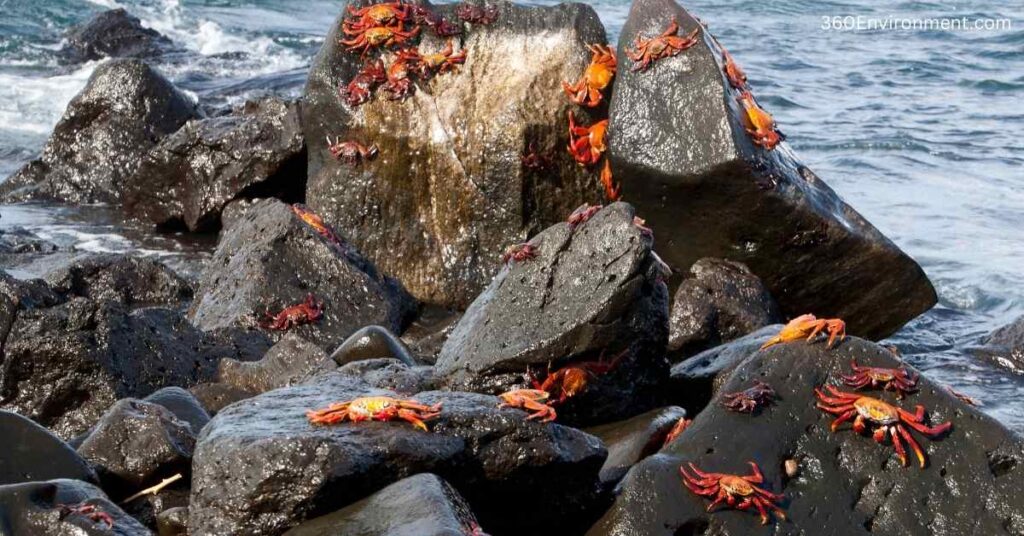
7.1 Human Impact
Human activities, such as coastal development, pollution, and tourism, can negatively impact the populations of Sally Lightfoot crabs.
- Habitat Loss: Coastal development can lead to the destruction of the rocky shoreline habitats that the Sally Lightfoot crab depends on. The construction of buildings, roads, and other infrastructure in coastal areas can reduce the availability of suitable habitat for the crabs.
- Pollution: Marine pollution, particularly oil spills and plastic waste, can harm Sally Lightfoot crabs and other marine organisms. Pollutants can contaminate the water and the algae that the crabs feed on, leading to health problems and reduced reproductive success.
7.2 Conservation Efforts
Although the Sally Lightfoot crab is not currently listed as endangered, conservation efforts aimed at protecting coastal habitats are essential for ensuring the long-term survival of the species.
- Marine Protected Areas: The establishment of marine protected areas (MPAs) can help protect the habitats of Sally Lightfoot crabs and other intertidal species. MPAs restrict human activities in certain areas, allowing ecosystems to recover and thrive.
- Sustainable Tourism: In areas like the Galápagos Islands, where tourism is a major industry, sustainable tourism practices can help minimize the impact on the environment. Educating tourists about the importance of protecting intertidal habitats can contribute to the conservation of Sally Lightfoot crabs.
8. Conclusion
The Sally Lightfoot crab (Grapsus grapsus) is an essential part of the ecosystems it inhabits, playing a crucial role in controlling algal growth, cycling nutrients, and serving as prey for a variety of animals. Its adaptability to the challenging conditions of the intertidal zone, combined with its agility and striking appearance, make it one of the most fascinating creatures of the rocky shorelines. While not currently at risk, the Sally Lightfoot crab’s habitat is increasingly threatened by human activities, and conservation efforts are necessary to ensure the continued health of these vibrant coastal ecosystems.
Understanding the environmental niche of the Sally Lightfoot crab not only highlights the importance of this species but also underscores the need for preserving the delicate balance of life in the intertidal zones where these crabs make their home.
Read More: Freshwater Crabs: A Critical Component of Aquatic Ecosystems

